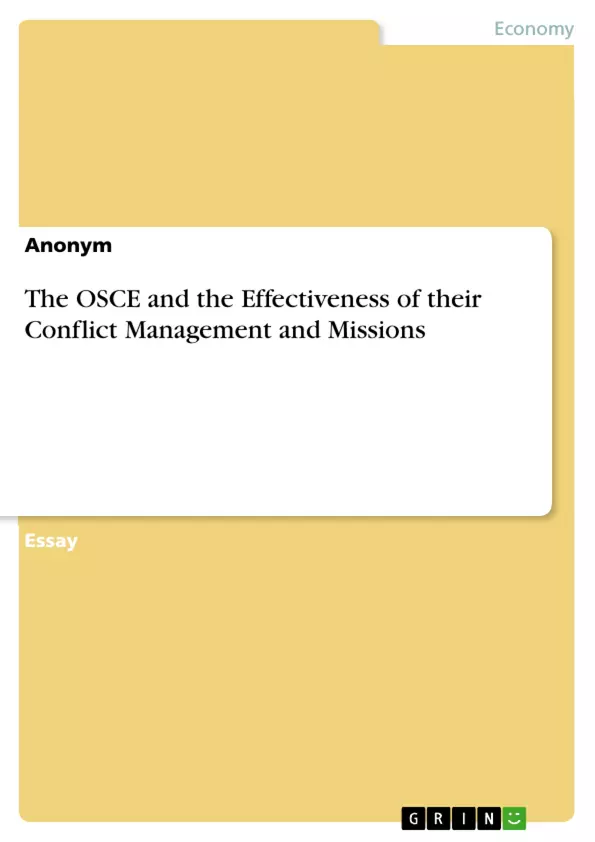In this paper, it will be analysed if the Organization for Security and Cooperation (OSCE) is able to successfully manage conflicts within Europe on the example of two case studies. Furthermore, to evaluate the OSCES`s effectiveness, a closer look at the different organs has to be done. In the essay conflict management will be also referred to as conflict resolution.
The world has never been peaceful, there were always conflicts around that states, people and organizations had to deal with. Today most of these conflicts have been mostly forgotten. However, even though the absolute number of war deaths has declined since 1946, the overall numbers of ongoing conflicts each years has increased, compared to the World War Ⅱ period. This increase is related to the more and more civil conflicts arising, on the contrary the conflicts between states have almost ceased to exit. Also the scale of conflicts has changed. Nowadays the world has to deal with small scale conflicts rather than large scale conflicts.
The OSCE aims at preventing and managing these conflicts within Europe. They have developed several activities to prevent and consolidate peace through eliminating the root causes of tension. They do so by strengthening the respect for human rights, building democratic institutions and fostering economic and social progress within and between States.
Inhaltsverzeichnis (Table of Contents)
- Introduction
- The Organization for Security and Cooperation in Europe
- Conflict Management in the OSCE
- Missions of the OSCE
- Kyrgyzstan
- Ukraine
- Conclusion
- Literature
- Online
Zielsetzung und Themenschwerpunkte (Objectives and Key Themes)
This paper analyzes the effectiveness of the Organization for Security and Cooperation in Europe (OSCE) in managing conflicts within Europe. The primary objective is to evaluate whether the OSCE is a successful tool for conflict resolution, specifically examining two case studies. The paper explores the different organs and mechanisms of the OSCE, focusing on their role in conflict management, and investigates whether the OSCE can effectively address various conflicts through its various structures and procedures.
- The role of the OSCE in conflict management within Europe
- The effectiveness of the OSCE's various organs and mechanisms
- Case studies of OSCE missions in Kyrgyzstan and Ukraine
- The OSCE's comprehensive approach to conflict management, including both broad and narrow definitions
- The OSCE's commitment to conflict prevention, resolution, and peacekeeping
Zusammenfassung der Kapitel (Chapter Summaries)
- Introduction: This chapter provides an overview of the global conflict landscape, highlighting the increasing number of civil conflicts and the OSCE's role in preventing and managing such conflicts within Europe. It emphasizes the OSCE's commitment to promoting human rights, democratic institutions, and economic and social progress.
- The Organization for Security and Cooperation in Europe: This chapter explores the history and structure of the OSCE, outlining its origins as the Conference on Security and Cooperation in Europe (CSCE) and its evolution into a permanent international organization. It details the OSCE's key objectives, including stability, peace, and democracy, and highlights its wide range of activities, such as arms control, border management, and conflict prevention and resolution.
- Conflict Management in the OSCE: This chapter delves into the OSCE's approach to conflict management, defining it in both broader and narrower terms. It outlines the different structures and institutions within the OSCE that are involved in the process of conflict management, including the Chairmanship, the Secretariat, the Office for Democratic Institutions and Human Rights, and the High Commissioner on National Minorities. Additionally, it discusses the various mechanisms, procedures, and instruments utilized by the OSCE in conflict management, emphasizing the importance of consensus-based decision-making and the OSCE's role as a third-party mediator.
Schlüsselwörter (Keywords)
The paper focuses on the OSCE as a tool for conflict management, examining its effectiveness in the context of contemporary conflicts. The main keywords are: conflict management, conflict resolution, OSCE, security, peace, democracy, human rights, international relations, case studies, Kyrgyzstan, Ukraine, early warning, conflict prevention, peacekeeping, and consensus-based decision-making.
- Quote paper
- Anonym (Author), 2019, The OSCE and the Effectiveness of their Conflict Management and Missions, Munich, GRIN Verlag, https://www.grin.com/document/1023042



